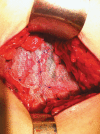Petit lumbar hernia--a double-layer technique for tension-free repair
- PMID: 25216420
- PMCID: PMC4253923
- DOI: 10.9738/INTSURG-D-13-00135.1
Petit lumbar hernia--a double-layer technique for tension-free repair
Abstract
This report describes an alternative technique for Petit hernia repair. The treatment of lumbar hernias should follow the concept of tension-free surgery, and the preperitoneal space can be the best place for prosthesis placement. An obese patient had a bulge in the right lumbar region, which gradually grew and became symptomatic, limiting her daily activities and jeopardizing her quality of life. She had previously undergone 2 surgical procedures with different incisions. We created a preperitoneal space and attached a mesh in this position. Another prosthesis was placed on the muscles, with a suitable edge beyond the limits of the defect. There were no complications. It has been described as a safe and tension-free repair for Petit hernia. In larger defects, a second mesh can be used to prevent further enlargement of the triangle and also to provide additional protection beyond the bone limits.
Keywords: Hernia; Lumbar hernia; Open repair; Prosthetic mesh repair.
Figures



References
-
- Wakhlu A, Wakhlu AK. Congenital lumbar hernia. Pediatr Surg Int. 2000;16((1–2)):146–148. - PubMed
-
- McCarthy MC, Lemmon GW. Traumatic lumbar hernia: a seat belt injury. J Trauma. 1996;40(1):121–122. - PubMed
-
- Loukas M, Tubbs RS, El-Sedfy A, Jester A, Polepalli S, Kinsela C, et al. The clinical anatomy of the triangle of Petit. Hernia. 2007;11(5):441–444. - PubMed
-
- Bathla L, Davies E, Fitzgibbons RJ, Jr, Cemaj S. Timing of traumatic lumbar hernia repair: is delayed repair safe? Report of two cases and review of the literature. Hernia. 2011;15(2):205–209. - PubMed
-
- Moreno-Egea A, Baena EG, Calle MC, Martinez JAT, Albasini JLA. Controversies in the current management of lumbar hernias. Arch Surg. 2007;142(1):82–88. - PubMed
Publication types
MeSH terms
LinkOut - more resources
Full Text Sources
Other Literature Sources

